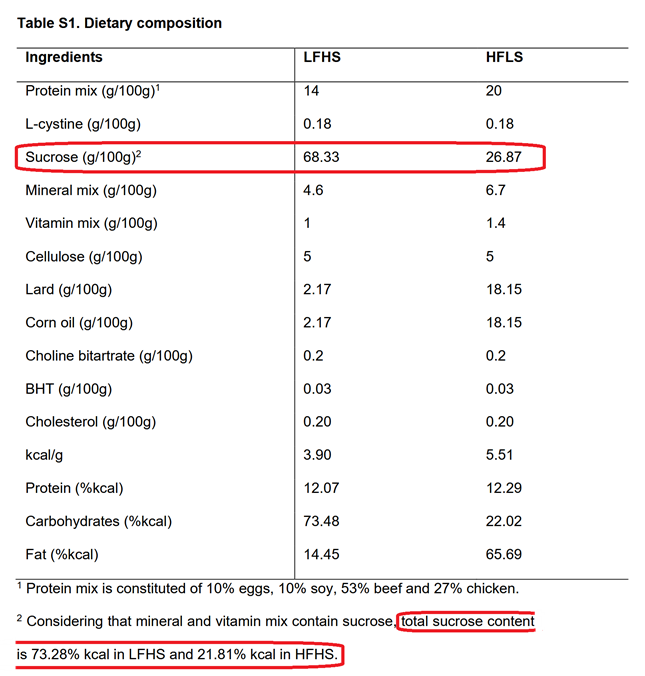Quick Study Analysis: Sugar and Obesity
tl;dr: What does one have to do for sugar to make you fat?
I posted a study a while back in the form of a poll:
It looked at three standard lab diets from the field of “Diet Induced Obesity”.
To save you reading that post, the 35% sugar (sucrose) diet (D12540B—left above, orange below) was the least obesogenic, and the 7% sucrose diet (D12492—right above, blue below) was the most obesogenic.
Maybe it wasn’t enough sugar? Today I came across the highest-sugar diet I’ve ever seen: a whopping 73% of calories from sugar.
The two studies are the Low-Fat, High-Sugar (LFHS) and High-Fat, Low-Sugar (HFLS):
Even their obesogenic high-fat diet is 22% sugar, more than the middle-of the road 17% sugar diet from the previous post.
The lower-sugar diet is massively more obesogenic, despite (because of?) the much lower sugar content.
Note that the calorie intake is almost the same.
“While energy intake did not differ between groups (Figure 3A), body weight was significantly higher for the HFLS-fed mice starting at 5 weeks of treatment and this difference persisted for 24 weeks (Figure 3B) resulting in a 3-fold increase in visceral obesity (Supplementary Table 2).”
Clearly some aspect of the high fat diet (a 50/50 combination of lard and corn oil) was causing a massive increase in obesity.
What could that be?
References
Perazza, L. R., Mitchell, P. L., Jensen, B. A. H., Daniel, N., Boyer, M., Varin, T. V., Bouchareb, R., Nachbar, R. T., Bouchard, M., Blais, M., Gagné, A., Joubert, P., Sweeney, G., Roy, D., Arsenault, B. J., Mathieu, P., & Marette, A. (2020). Dietary Sucrose Induces Metabolic Inflammation and Atherosclerotic Cardiovascular Diseases More Than Dietary Fat in Ldlr-/- Apob100/100 Mice. Atherosclerosis, 0(0). https://doi.org/10.1016/j.atherosclerosis.2020.05.002










Corn oil os 60% linoleic acid. I believe other studies that avoid linoleic acid intake as a portion of fat intake, do not show calorically equal hi fat diets causing more wt gain
"Clearly some aspect of the high fat diet (a 50/50 combination of lard and corn oil) was causing a massive increase in obesity. What could that be?"
The lard alone can be obesogenic for mice due to the high linoleic acid content.
https://www.intechopen.com/chapters/41405
In addition, lard also can contain considerable quantities of arachidonic acid. https://www.altmeyers.org/en/allergology/arachidonic-acid-134782#:~:text=Arachidonic%20acid%20in%20food%3A,230%20mg%20per%20100%20g)
It's may not make sense, however, to generalize from murine experiments because the gut microbiome interacts with various combinations of amino acid, fatty acid, and simple/complex sugars to produce all manner of obesogenic and anti-obesigenic effects. https://www.sciopen.com/article/10.26599/FSHW.2024.9250070
It has been shown that insulin sensitivity improves when linoleic acid intake exceeds levels that typcally induce obesity in rats. https://journals.physiology.org/doi/full/10.1152/ajpendo.00032.2014
That's because, at high enough concentrations, linoleic acid molecules can displace arachidonic acids from their positions in cell membranes. https://pmc.ncbi.nlm.nih.gov/articles/PMC2875212/
The same response is seen in humans as illustrated by this narrative. "Using large prospective datasets, higher blood levels of LA were associated with lower risk of coronary heart disease, stroke and incident type-2 diabetes mellitus compared with lower levels, suggesting that, across the range of typical dietary intakes, higher LA is beneficial." https://pmc.ncbi.nlm.nih.gov/articles/PMC11391774/
Typically, risk of mortality decreases by an estimated 17% across the range of typical dietary intakes of LA. In light of the fact that most people alive today are destined to die from either heart disease or cancer, that 17% decreased risk might be compared to shifting from a position on a battlefield under heavy fire with little cover to a more protected area with less enemy fire. Clearly, exiting the battlefield would effectively eliminate risk of death from enemy fire. Likewise, decreasing linoleic acid intake to a levels that don't exceed physiological requirements by a significant margin could, theoretically, eliminate risk of death from chronic inflammatory disease. But that hypothesis has yet to be tested on humans. https://karger.com/anm/article/58/1/59/40551/ISSFAL-2010-Dinner-Debate-Healthy-Fats-for-Healthy